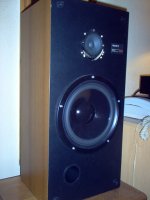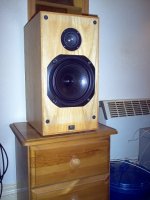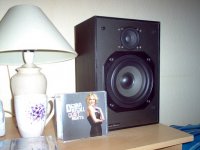I think ought to hit the hay in the UK. Way past my bedtime. 😀
Taking crossover low is a general solution full of pitholes as Lynn Olson wisely says:
http://www.diyaudio.com/forums/multi-way/190663-can-you-have-sparkling-treble-but-without-sibilance-2.html#post2604196
I don't mind metal tweeters as long as they have a Zobel to tame high frequency nasties.
We do know that a three way works much better than a two way though. I find an 8" bass works better tonally with two ways. A couple of models of mine below. Both are musically satisfying IMO.
I was reassured that Troels Gravesen shares my opinion. TQWT-
To be continued another day.
Taking crossover low is a general solution full of pitholes as Lynn Olson wisely says:
http://www.diyaudio.com/forums/multi-way/190663-can-you-have-sparkling-treble-but-without-sibilance-2.html#post2604196
I don't mind metal tweeters as long as they have a Zobel to tame high frequency nasties.
We do know that a three way works much better than a two way though. I find an 8" bass works better tonally with two ways. A couple of models of mine below. Both are musically satisfying IMO.
I was reassured that Troels Gravesen shares my opinion. TQWT-
To be continued another day.

Attachments
re: "little 10L speaker I usually feel like kicking round the room" - Steve, what drivers are they?
Hi keilau,
Thought this link might be of interest to you.
http://www.diyaudio.com/forums/multi-way/189530-kef-104-kef-104ab-mkii-spice.html
Peter
Thought this link might be of interest to you.
http://www.diyaudio.com/forums/multi-way/189530-kef-104-kef-104ab-mkii-spice.html
Peter
It's some sort of Elac 6" bass from the eighties fitted in the Mordaunt Short MS15. Rubber dustcap being an Elac characteristic. I use a Visaton TW70 with it since it fits.re: "little 10L speaker I usually feel like kicking round the room" - Steve, what drivers are they?
Originally the bass just had a 0.4mH coil, and second order 3.3uF/0.3mH Audax mylar tweeter with a 3.3R resistor. Sounded harsh and lots of cone breakup around 5kHz I guess.
I believe I have 2.5mH and 6.8uF bass with a tank notch of 33R and 0.33 uF around 6kHz, not too sure, and a third order 3kHz tweeter now. Cone tweeters need steeper filters IME. Cabinet is too small fundamentally.
Attachments
Last edited:
Hi keilau,
Thought this link might be of interest to you.
http://www.diyaudio.com/forums/multi-way/189530-kef-104-kef-104ab-mkii-spice.html
Peter
Peter, thank you for the link.
I am very interested in the discussion on Vifa D27TG-35. Both Falcon and Willslow recommend it as a potential KEF T27 substitute. But they did not give the reason nor offer any information on crossover mod from the T27. The Vifa D27TG-35 was mentioned in the link above, but no follow-up discussion.
I have a pair of the Vifa D27TG-35 sitting on my shelf waiting for application.
I'm not sure that a third order KEF AB circuit is really helping you here, keilau. I have had some goodish results with the classic KEF 8" bass third order butterworth 3kHz BW3 filters, but these rely on the negative polarity on tweeter trick that works because of the approx 5cm distance between acoustic centres with this sort of BBC speaker.
I think you should be looking at a time aligned LR2 circuit. Because 6" bass just doesn't rolloff very fast. Troels gets a bit vague on detail with his preferred 2.5kHz v3 LR2 crossover, but not hard to model if you get the basic ideas:
18W-8434G00
This is not a journey I will share with you, because I have my own interests in musical speakers that are cheap to build, but I think you'd end up with something good. FWIW, Troels is still doing a Fs tweeter notch which works much like a KEF AB in practise. It all seems to make sense at a theoretical level, and is really pushing the envelope IMO. 😎
Here's an online calculator I use frequently to work out where notches act and with what Q:
Alan Yates' Laboratory - VK2ZAY's Engineering Calculators - LCR Resonance
Amazing what good stuff is available online through the goodness of the author's heart. 🙂
I think you should be looking at a time aligned LR2 circuit. Because 6" bass just doesn't rolloff very fast. Troels gets a bit vague on detail with his preferred 2.5kHz v3 LR2 crossover, but not hard to model if you get the basic ideas:
18W-8434G00
This is not a journey I will share with you, because I have my own interests in musical speakers that are cheap to build, but I think you'd end up with something good. FWIW, Troels is still doing a Fs tweeter notch which works much like a KEF AB in practise. It all seems to make sense at a theoretical level, and is really pushing the envelope IMO. 😎
Here's an online calculator I use frequently to work out where notches act and with what Q:
Alan Yates' Laboratory - VK2ZAY's Engineering Calculators - LCR Resonance
Amazing what good stuff is available online through the goodness of the author's heart. 🙂
Last edited:
I'm not sure that a third order KEF AB circuit is really helping you here, keilau. I have had some goodish results with the classic KEF 8" bass third order butterworth 3kHz BW3 filters, but these rely on the negative polarity on tweeter trick that works because of the approx 5cm distance between acoustic centres with this sort of BBC speaker.
I think you should be looking at a time aligned LR2 circuit. Because 6" bass just doesn't rolloff very fast. Troels gets a bit vague on detail with his preferred 2.5kHz v3 LR2 crossover, but not hard to model if you get the basic ideas:
18W-8434G00
This is not a journey I will share with you, because I have my own interests in musical speakers that are cheap to build, but I think you'd end up with something good. FWIW, Troels is still doing a Fs tweeter notch which works much like a KEF AB in practise. It all seems to make sense at a theoretical level, and is really pushing the envelope IMO. 😎
Here's an online calculator I use frequently to work out where notches act and with what Q:
Alan Yates' Laboratory - VK2ZAY's Engineering Calculators - LCR Resonance
Amazing what good stuff is available online through the goodness of the author's heart. 🙂
Steve, you are throwing stuff at me faster than I can digest! LOL😉
I will finish my current Peerless-Dayton_Audio bookshelf with the commercial tricks #1 and #3 that Gravesen quoted.
#1. Use an asymmetrical crossover usually consisting of 2nd order to the bass and 3rd order to the tweeter to make "proper" phase integration.
#3. Tilt the front panel so that with a listening height somewhere between the bass and tweeter we more or less compensate for the time difference.
I will re-examine the crossover by investigating the benefit of notch filters at both the woofer and the tweeter side.
I am giving up the acoustic Butterworth for the Peerless-Audax bookshelf. I could not figure out how to get the Martin Colloms' transformation equations to work right.
The time aligned LR2 will be for a future project.
I found this LRC calculator and like it.
CalcTool: RLC or LC circuit calculator
Sloped baffles seem to work well enough. Below is one that somebody built for a series crossover I rustled up with Visaton drivers that play nicely together. The tweeter is set back about 2 cm.
The series filter is quite neat, and includes a hidden tweeter Fs of 1.8kHz correction along with a notch on the bass around 6kHz. Apparently it sounded good. The 1 ohm resistor is optional, and just takes down a little 2dB peak at crossover to get nearer a pure 24dB/octave LR4. Each driver gets a Zobel that matches its inductance and DCR.
Impedance Equalization (L-Pad) Circuit Designer / Calculator
For me, this was more a theoretical exercise than anything. I had become interested in the 3:1 ratio of components in classic filters. That phase alignment is quite impressive IMO. Should sound very integrated. But as I said, this sort of design is not my primary interest. 🙂
It would be much harder to do this with notches on a parallel circuit.
The series filter is quite neat, and includes a hidden tweeter Fs of 1.8kHz correction along with a notch on the bass around 6kHz. Apparently it sounded good. The 1 ohm resistor is optional, and just takes down a little 2dB peak at crossover to get nearer a pure 24dB/octave LR4. Each driver gets a Zobel that matches its inductance and DCR.
Impedance Equalization (L-Pad) Circuit Designer / Calculator
For me, this was more a theoretical exercise than anything. I had become interested in the 3:1 ratio of components in classic filters. That phase alignment is quite impressive IMO. Should sound very integrated. But as I said, this sort of design is not my primary interest. 🙂
It would be much harder to do this with notches on a parallel circuit.
Attachments
-
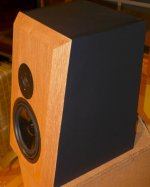 system7_TimeAligned_SerialXO.jpg66.3 KB · Views: 117
system7_TimeAligned_SerialXO.jpg66.3 KB · Views: 117 -
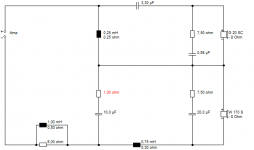 S7 Series Crossover Time Aligned.PNG8.6 KB · Views: 117
S7 Series Crossover Time Aligned.PNG8.6 KB · Views: 117 -
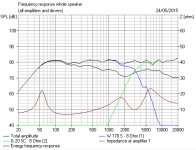 S7 Series Crossover Freq Response.PNG19.5 KB · Views: 78
S7 Series Crossover Freq Response.PNG19.5 KB · Views: 78 -
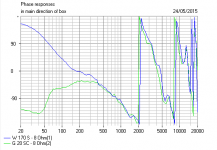 S7 Series Crossover Phase.PNG18.5 KB · Views: 71
S7 Series Crossover Phase.PNG18.5 KB · Views: 71 -
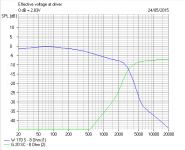 S7 Series Crossover Electrical Response.PNG17.2 KB · Views: 68
S7 Series Crossover Electrical Response.PNG17.2 KB · Views: 68 -
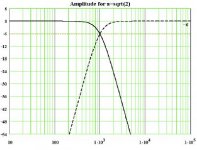 Aequal_root2_Steen_Duelund_filter.JPG34.6 KB · Views: 66
Aequal_root2_Steen_Duelund_filter.JPG34.6 KB · Views: 66
Last edited:
- Status
- Not open for further replies.
- Home
- Loudspeakers
- Multi-Way
- Converting 3rd order Butterworth to aB
